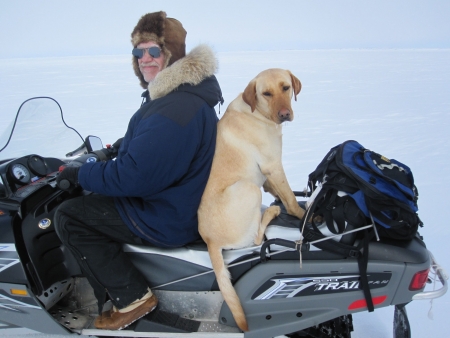By: Brendan P. Kelly, currently Executive Director of the IARPC and Assistant Director for Polar Science in the White House Office of Science and Technology Policy

My friend and colleague John Farrell, Executive Director of the Arctic Research Commission, recently surfaced a publication from a couple of decades back by a former Chair of that Commission. John noted that many of the same issues we are tackling now in Arctic research were current back then. On the other hand, I would argue that our understanding of many of the topics has advanced tremendously in the past couple of decades, because there are a lot of very talented people working hard on those issues. ARCUS, the Study of Environmental Arctic Change, the Arctic Research Commission, and other organizations have become more and more adept at promoting and coordinating the efforts of a creative and hard-working research community.
What has changed even more, I think, is the degree of communication between disciplines and the emphasis on integrating traditional knowledge and science. To be clear, we are far from proficient at that integration, but its importance is more consistently appreciated even as we struggle to make it a reality.
Within the Federal government, there have been substantial advances in coordination of research and other issues in the Arctic. The Interagency Arctic Research Policy Committee (IARPC) was given a great boost when the President's science advisor made it a subcommittee in the National Science and Technology Council and when the National Science Foundation increased staffing support for the committee. With that boost, IARPC produced the Arctic Research Plan: FY2013 – 2017 and stood up 12 teams to implement the plan. Thanks to cat herder par excellence, Sara Bowden (serving as IARPC's Executive Secretary); Sandy Starkweather; and dedicated team leaders, the teams are advancing the milestones spelled out in the research plan. There are somewhere on the order of 300 people (and growing) involved the effort, and I forever marvel at what Sara and Sandy keep moving.
Recently, we expanded the implementation teams to include non-Federal collaborators and have been convening meetings of these broader "collaboration teams." From time-to-time it is necessary, for reasons of fairness and legalities, to convene only the Federal implementation teams. For example, developing solicitations for Federal funding must not include people from outside of the Federal government. Most often, however, the teams convene to communicate and coordinate all of the talent (Federal or otherwise) working in their topic area, and for those we want to harness all of the available talent wherever it resides; hence, collaboration teams. We continue to seek involvement of researchers wanting to contribute to the combined efforts. The full list of teams can be seen online here. The website is soon to be enhanced to support the collaboration teams and communicate with wider audiences. Sara, Sandy, Helen Wiggins, and others on the ARCUS staff are doing excellent work to make the website a powerful tool.
Research planning is necessarily iterative, and IARPC is planning to update its research plan. To that end, IARPC agencies sponsored the recently released Polar Research Board study on emerging issues in the Arctic (The Arctic in the Anthropocene: Emerging Research Questions) . That excellent report will help bring the thinking of the greater research community in to IARPC planning.
All of which is to say, this is a good time to sneak out of my role as Assistant Director for Polar Science in the White House Office of Science and Technology Policy (OSTP). In that position, I have served as Executive Director of the IARPC and had the very great pleasure of seeing the Arctic research community make great strides not only in understanding the Arctic system but also in pulling together so that they realize the benefits of coordination.
I have used the analogy of harnessing dogs to sleds to describe what it takes to get scientists to coordinate their efforts (lest my colleagues not appreciate being likened to dogs, I hasten to point out that my best field companions were very smart Labrador retrievers, so I mean the analogy with the greatest respect). Tandem hitches—dogs harnessed closely to one another pulling in two parallel lines—are efficient in that they enforce pulling in one direction. Fan hitches, in contrast, have each dog on their own trace connected to the sled; the dogs are fanned out in front and pull only in the same general direction. The loss of efficiency in the fan hitch, however, tends to be compensated by the fact that the arrangement is more consistent with dog sociality. Dogs like to preserve some interpersonal distance. The independence of scientists, likewise, is preserved when they are not tied to a single direction. Forcing them along a single trajectory (as if anyone could!) would stifle important creativity. On the other hand, tough problems like many of those faced in the Arctic are well served by groups pulling in the same general direction. The person on the back of the sled generally gets a terrific ride, although occasionally finds him or her self untangling some traces.
OSTP hopes to bring on a new Assistant Director for Polar Science soon, and in the meantime, Simon Stephenson, Section Head for Arctic Science at NSF, will take on the role of Executive Director of IARPC. That is especially appropriate given that Simon has consistently provided the big-picture vision for IARPC. And, he is adept at fan hitches.
After June 20, 2014, I shall be at the address below and keen to aid the overall efforts in a new role.
Thanks for all of your patience and support.
Brendan P. Kelly
Director of Conservation Research and Chief Scientist
Monterey Bay Aquarium
886 Cannery Row
Monterey, CA 93940
bkelly [at] mbayaq.org
831-648-4934
